Before modern gaming giants and jaw-dropping graphics, video games were mostly lines of code, pixels, and beeps. But for many, those early games weren’t just entertainment—they were stepping stones into the world of computing. They taught logic, revealed what computers could do, and often introduced players to programming itself. Games like Minesweeper, still enjoyed through platforms such as minesweeper online, show how simple mechanics continue to engage minds and teach problem-solving.
For fans of gaming and tech history, looking back at these classics is more than nostalgia. It’s a way to understand how simple ideas became the foundation for entire industries.
Early Pixels, Lasting Impact
The 1970s and 1980s gave us more than retro aesthetics. They were filled with experiments—games written by students, hobbyists, and engineers who often had no roadmap. What they built, though, ended up shaping not just gaming, but how people interacted with computers.
From the blocky mazes of Pac-Man to the space races in Asteroids, every beep and byte pushed systems to their limits. These weren’t games made for billion-dollar revenue—they were projects built on curiosity, creativity, and raw code.
Highlights from the Birth of Game Programming
Let’s look at some of the earliest titles that left a serious mark on computing—and in many cases, helped people understand what computers could actually do.
Spacewar! (1962)
This two-player space combat game was one of the first to use real-time graphics. Created on a PDP-1 mainframe at MIT, Spacewar! wasn’t just fun—it was groundbreaking. Many developers who later worked in Silicon Valley say this game made them curious about coding and hardware.
It ran on a system with no real operating system, and every element had to be coded from scratch. Its logic-based gameplay and control systems also inspired future developers to consider how players interact with machines.
Colossal Cave Adventure (1976)
This text-based game is a true cornerstone. Built by Will Crowther and expanded by Don Woods, it brought storytelling to computing in a way that hadn’t been done before. It’s often cited as the spark for the entire interactive fiction genre.
Players navigated caves, solved puzzles, and typed out commands in full sentences. While the interface was basic, the immersion was real. More importantly, it demonstrated how games could be about imagination, not just reflexes.
Pong (1972)
Created by Atari’s Nolan Bushnell and Allan Alcorn, Pong is often considered the first widely successful arcade game. Its simple paddle-and-ball mechanics were easy to grasp but surprisingly fun.
Pong didn’t just entertain. It introduced a generation of players to interactive digital systems. It also showed that games could be commercially viable—a fact that would shape the tech landscape for decades.
Zork (1980)
Built on the ideas from Colossal Cave Adventure, Zork added complexity, humor, and better parsing. It ran on many home computers, helping popularize machines like the Commodore 64 and Apple II.
Because it was text-based, Zork encouraged players to think through logic puzzles and read carefully. Many early users report learning to type and write better just from trying to get through this game.
How These Games Shaped Tech Culture
What makes these titles so important isn’t just their gameplay—it’s the way they introduced people to thinking like a programmer.
When early players couldn’t beat a level or wanted to tweak something, many of them looked under the hood. Some cracked open the code. Others rewrote parts or created their own versions. That hands-on experience led directly to careers in computing.
Some schools even used games as entry points to teaching logic and programming. Others handed out game source code to help students understand system architecture.
It’s not a stretch to say that some of today’s top engineers wrote their first lines of code trying to hack Doom, mod Quake, or get King’s Quest to run on an old PC.
Influence on Modern Game Design
While today’s developers have access to engines like Unity and Unreal, many foundational ideas come from these early experiments. Games like Minecraft reflect the DIY spirit of early programming culture. Titles like Celeste and Undertale use retro visuals and minimalist design in ways that honor these roots.
Game mechanics—like turn-based strategy, text input, or even save points—were first figured out during these early years. And they remain part of the toolbox for developers today.
Even graphics-heavy modern games still rely on the same basic event loops, state machines, and conditionals that powered Zork or Tetris. Many of the best modern devs admit that learning old systems helped them better understand new tools.
Learning Through Nostalgia
There’s a growing movement of younger devs who learn by rebuilding old games. It’s not just for fun. Rewriting a simple game like Snake or Breakout is a great way to learn logic, structure, and basic physics.
Classic game jams, retro coding clubs, and emulation projects continue to build communities where this learning thrives. Some devs even release demakes—modern games reimagined as if they were written in 1983.
At a time when everything moves fast, these slower, older games provide a chance to pause and learn.
Why It Still Matters
These games didn’t just shape entertainment. They shaped how people learned, thought, and connected with technology. They showed what computers could be—and what people could build with them.
For many geeks, the path from player to coder started with a blinking cursor or a bouncing pixel. And for that reason alone, these early titles will always deserve a place in the story of computing.
